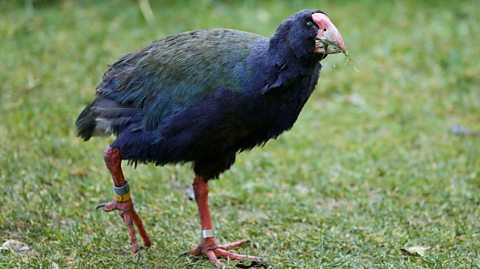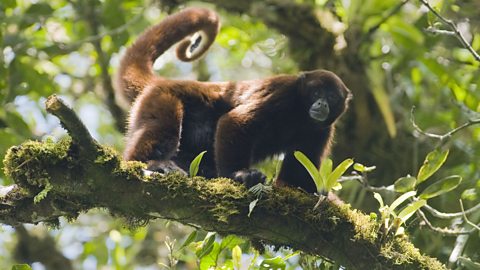When is an extinct animal not extinct?
Generally speaking, extinction is forever – debate rages on over the re-emergence of the dire wolf and the Jurassic Park series is still just the stuff of nightmares, albeit entertaining ones.
Around 99% of living things that have ever existed are now extinct – meaning for animals, that they have stopped breeding, died and no longer exist.
But sometimes, dedicated conservationists refuse to take extinct for an answer – and through specific targeted research, or plain good fortune, discover that there’s still life in the old species yet.
BBC Bitesize takes a look at four animals that were believed to be extinct – until they weren’t.
South Island takahē
When you think of extinct species, there is a flightless bird that immediately comes to mind.
While there haven’t been any dodos on the planet for over 450 years, the South Island takahē has managed to avoid that fate.
Takahēs are short, stocky colourful birds – with purple-blue plumage and green backs. They are native to New Zealand, and, as the name suggests, were originally present in the country’s South Island.

Following pressures from hunters, introduced predators and competition for food, the species dwindled and in the late 19th Century was feared to have died out completely – a fate that actually befell the North Island takahē.
However, in 1948, the takahē was rediscovered in the Murchison Mountains, to the south-west of Queenstown. Since then, the country has enacted its longest running endangered species programme.
Groups of takahē have been introduced to areas of New Zealand without predators – across both the north and south islands - and as of 2024, they were thought to be a population of around 500.
Coelacanth
Thanks to its appearance as a rare fish in the popular life-sim game Animal Crossing, the coelacanth has had a bit of a resurgence in recent years.
But the prehistoric fish was thought extinct until 1938.
Existing as a species for more than 400 million years, a coelacanth can grow to around 2m long and weigh 100kg and has a life span of around 100 years.
When a large fish with blue, scaly, fleshy fins was discovered in a trawl net in South Africa, experts confirmed that a species feared extinct for 70 million years had been found.
It took another 14 years for a second coelacanth to be found – this time off the coast of the Comoro Islands. While more and more of the species have been discovered, primarily off the east coast of Africa, the coelacanth remains in small numbers and endangered.
Fagilde’s trapdoor spider
While spiders are certainly not everybody’s cup of tea, even the most ardent arachnophobe must be slightly curious about the rediscovery of a tap-dancing spider.
While Fagilde’s trapdoor spider won’t be lining up on Strictly anytime soon, their recent discovery did end fears that the rare species had died out.
Named after the Northern Portuguese area in which they were found, the Fagilde’s trapdoor spider had last been seen in 1931. No males have ever been sighted, but it’s believed that they behave in the same way as similar species, by ‘tap-dancing’ at a female’s door in order to mate.
The females discovered in 1931 grew to about 2.2cm long and were noted for their unusual horizontal burrows. These burrows were found again in Fagilde in 2011 – and researchers painstakingly mounted expeditions in the area in an attempt to spot the reclusive spider.
In 2023, a female was discovered with 10 offspring and it was confirmed through minimally invasive DNA testing that it was from the presumed extinct species. The population remains low – efforts are ongoing through education in the region to ensure the limited numbers can survive and grow.
Peruvian yellow-tailed woolly monkey
A species of cultural significance in Peru, appearing on stamps and coins, the Peruvian yellow-tailed woolly monkey was rediscovered in the late 20th Century, through a series of fortunate coincidences.
Naturalist Alexander von Humboldt originally discovered the species in 1802 – although his initial searches only found the animals’ skins, which were being used as saddles.
It took over a century for another sighting of significance, but the rare primate had not been spotted since 1926 and was feared extinct.

That was until 1974, when experts toured Peru. Low on funds, they relied on hitching rides to tour the Andes and met some hunters – one of whom showed them a freshly-caught monkey skin, matching the description of the missing species.
This confirmed for the researchers that the species was still alive, and another happy accident backed up their theory a month later. In a village in northern Peru, they met a soldier who just happened to be keeping a yellow-tailed woolly monkey as a pet.
Nine years later, after more pet discoveries, the team found one of the primates in the wild. The species remains endangered – due to the vast space of their habitat, it’s thought there could be anywhere between 1,000 and 10,000 of the monkeys in Peru.
This article was published in April 2025
Meet the animals that live in the most extreme environments
From the mouse at the top of a volcano to the worms at the bottom of the ocean, BBC Bitesize takes a look at the animals that live in the wildest of habitats

10,000 naps a day? The amazing world of animal sleep
BBC Bitesize looks at four weird and wonderful ways that animals go to sleep.

Archaeology: The ancient wonders we're still waiting to find
The ground may still be hiding historic settlements or intriguing remains
